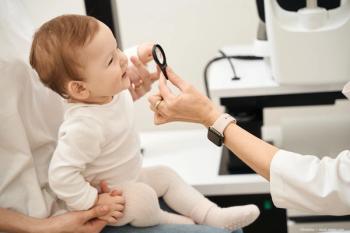
Optic neuritis treatments vary greatly for NMO and MS
Optic neuritis in juvenile neuromyelitis optica (NMO) Optic neuritis treatments vary greatly for NMO and MS
Martinique, French West Indies-Optic neuritis in juvenile neuromyelitis optica (NMO) is a potentially blinding disease in pubescent and post-pubescent patients in the French West Indies. The treatments used for relapses of the disease and prevention are not well defined; however, they are very different from those used to treat patients with multiple sclerosis (MS). The critical need is to be able to differentiate between MS and NMO before treatment is initiated to preserve the visual and motor functions of those young patients, according to Rabih Hage, MD.
“Neuromyelitis optica is an inflammatory demyelinating disorder that is characterized by recurrent episodes of optic neuritis and acute myelitis. In 2004, a specific antibody, NMO-IgG, was described that binds the aquaporin-4 aqueous channel that is involved in the homeostasis of the central nervous system,” Dr. Hage said. He is medical doctor in the University Hospital of Fort-de-France in Martinique, French West Indies.
That important discovery led to the revision of the diagnostic criteria for NMO (the Wingerchuk criteria). A diagnosis of NMO now requires the presence of optic neuritis, acute myelitis, and at least two of the following three supportive criteria: a contiguous spinal cord lesion seen on magnetic resonance imaging (MRI) that extends over three vertebral segments, a brain MRI study that does not meet the diagnostic criteria for MS, and NMO-IgG seropositivity, according to Dr. Hage.
NMO is extremely disabling in adult patients, who can become severely visually impaired.
“Sixty percent of patients with NMO are legally blind 15 years after a relapse,” Dr. Hage said.
Studies of pediatric patients with NMO have reported conflicting results, said Dr. Hage. In 1996, Jeffrey and colleagues reported nine patients with a viral prodrome, rapid visual and neurologic recovery, and no recurrence of their symptoms. A study published in 2007 by Banwell and associates described relapsing NMO in nine of 17 patients. Finally, the following year McKeon and colleagues identified residual visual impairment in 26 of 48 pediatric patients who were seropositive for NMO-IgG.
Dr. Hage and colleagues conducted an observational retrospective case study to describe the ophthalmologic characteristics of optic neuritis in a series of pediatric patients in the French West Indies and to determine the visual acuity outcomes of optic neuritis following acute treatment. The patients all had a diagnosis of NMO based on the new criteria, an age of onset less than 18 years, and had undergone two ophthalmologic examinations at least 6 months apart in the ophthalmology department in the Fort-de-France University Hospital, Dr. Hage explained.
He reported that 92 patients had NMO spectrum disease, and of those, 11 patients had an onset of disease before age 18. The remaining patients had disease onset after age 18. Two of the 11 patients with juvenile onset were excluded because of limited forms of NMO, that is, severe optic neuritis; one other patient had probable NMO but died before the MRI imaging study in the early 1990s. The remaining eight patients had definite NMO disease based on the Wingerchuk criteria.
The mean age of disease onset in the eight patients was 15 years. Girls were predominantly affected. All patients were of African-Caribbean descent except for one Hispanic patient. Only one of the eight patients had a viral prodrome; the first symptom was acute disseminated encephalomyelitis. Five patients tested positive for NMO-IgG.
Review of the patient records indicated that 20 episodes of optic neuritis occurred in 14 eyes. Six cases of optic neuritis occurred simultaneously with a spinal cord attack. Two patients developed optic neuritis in only one eye. The average time to relapse was 2.8 years (range, 1 to 4 years); three patients had simultaneous bilateral optic neuritis. Most patients (62%) reported severe pain that was associated with ocular movements. The peak of optic neuritis was always associated with the worse visual acuity, below 20/200. No patient had a pupillary reflex, and two patients had papilledema.
“The results indicated that blindness can still occur despite a 5-day course of high-dose corticosteroids; two patients had a visual acuity below 20/200. Four patients had complete recovery of the visual acuity to that before the onset of the disease. One patient with bilateral optic neuritis had a complete recovery of visual acuity to that before the onset of the disease with plasma exchange in addition to the course of corticosteroids. Four patients had incomplete recovery with a markedly lower visual acuity 6 months after the onset of optic neuritis,” Dr. Hage reported.
When the data were analyzed by the number of episodes of optic neuritis, six eyes of eight patients were blind 6 months after the onset of optic neuritis. Three patients became blind after only one episode of optic neuritis.
Dr. Hage explained that juvenile cases of NMO are not rare and represent 9% of the NMO cohort in the French West Indies. The clinical characteristics of juvenile NMO appear to be the same as those in adults with NMO optic neuritis and in children with MS optic neuritis.
The results of that study differed from previously reported cases of juvenile NMO in that in the current study all patients had a relapsing course, only one patient had a viral prodrome, optic neuritis led to decreased visual acuity in 64% of eyes, and 33% of patients with optic neuritis were blind, despite aggressive treatment, he pointed out.
“One might speculate that a parainfectious form of the disease has to be distinguished from the remittent and idiopathic forms, which are more severe,” Dr. Hage emphasized.
The investigators concluded that NMO is a potentially blinding disease in pubescent and post-pubescent individuals in the French West Indies. Treatments for relapses and prevention of the disease are not well defined; however, they differ radically from those used to treat patients with MS.
“Importantly, there is a critical need to differentiate NMO from MS before starting any treatment in order to preserve the visual and motor functions of these young patients,” Dr. Hage concluded.
Dr. Hage has no financial interest in this subject matter.
For more articles in this issue of Ophthalmology Times eReport,
Newsletter
Don’t miss out—get Ophthalmology Times updates on the latest clinical advancements and expert interviews, straight to your inbox.













































.png)


